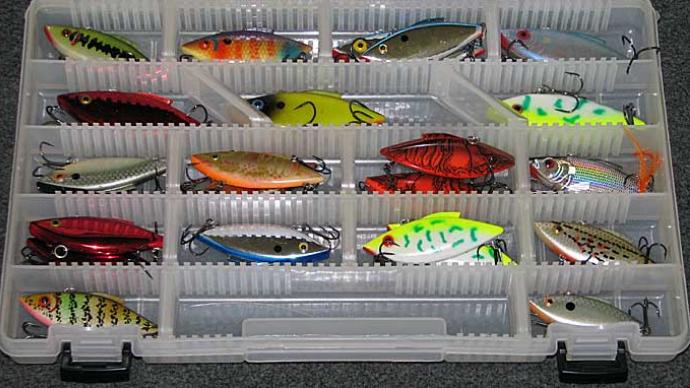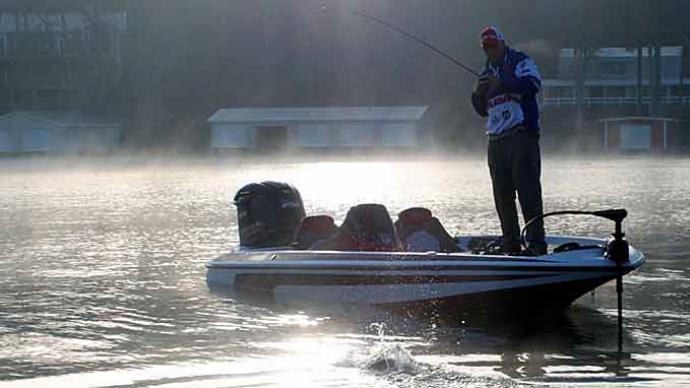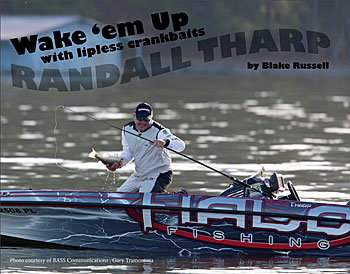
Lipless crankbaits have been around longer than most of today’s anglers have been alive. It can be a presentation that’s easily overlooked because of how long they’ve been around. A lipless crankbait doesn’t grab your attention like the flashiest new lures. Just looking at the thing would make one think it doesn’t do much. It’s easy to get caught up in the next great thing, but lipless crankbaits have been around for a long time for a reason. I’d say that you’d be a fool not to have a lipless crankbait tied on during the early pre-spawn. Randall Tharp tells us why.
Lipless Crankbaits Wake Up Fish
Tharp loves fishing in the late winter and early spring because it is usually your best chance of catching many big fish. Tharp believes that the biggest fish spawn first, and these bigger fish will prepare for the spawn before the smaller fish do. This prospect sounds thrilling, but cold water can make fish challenging to catch. “Water temperatures are still very cold in the late winter and early spring. As a result, the fish's metabolisms slow down, so they eat less often. Fish also don’t expend as much energy during this time, so it can be tough to catch them,” Tharp says.
You could argue that the fish are sleepy during this time of year. However, Tharp believes a lipless crankbait is the best presentation to wake the fish up with. Tharp says, “There’s something about a lipless crankbait that causes the fish to bite. The loud noise they produce, the tight vibrating action, the wobble they have on the fall when you kill the retrieve, the amount of flash they have in the water - all these things cause these lethargic fish to react and bite when they otherwise wouldn’t.”
Lipless Crankbaits Quickly Cover Water
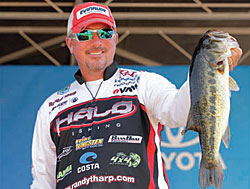
When Tharp looks for big pre-spawn bass, he looks for drop-offs near spawning areas. The change in depth can be as little as a foot, and Tharp finds these small, subtle drops will often hold some of the biggest bass you’ll catch all year. Finding the perfect spawning bay with the perfect drop nearby doesn’t guarantee you’ll find bass, though.
One of the most popular ways to fish a lipless crankbait is to fish it fast. Tharp will cover a lot of water in this period to find the fish he’s after. His search often starts in the upper reaches of creeks. Even though water temperatures are still very cold in late winter and early spring, big fish will still be relating close to spawning areas. Ditches, channel swings, points, secondary points, or even an unassuming subtle ledge are all excellent options if they’re located near spawning bays. Tharp quickly fishes these structures, starting closest to the spawning area, and working his way back toward the main lake until he finds the fish. He finds structures with grass, stumps, or even shell beds tend to be best. Once Tharp gets bit, he will begin to slow down and pick the area apart.
Lipless Crankbaits Are Versatile
If you think throwing lipless crankbait limits you to fishing fast on a flat, you’ve thought wrong. While it’s common knowledge that burning a lipless crankbait over a flat with grass or stumps will catch a lot of fish, you’re limiting yourself if this is the only way you fish it.
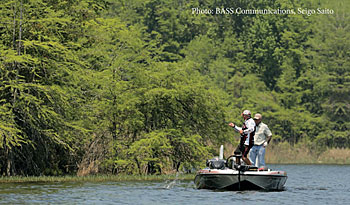
Tharp will fish a lipless crankbait as shallow as 1 foot and as deep as 15 feet. Depending on the depth of the water he’s fishing, he will upsize or downsize his crankbait accordingly to keep it in the strike zone. Burning it might be less than ideal in some places, but Tharp prefers fishing a lipless crankbait differently. “There have been many times where I’ve pulled up on a spot where a jig or other lure won’t catch fish. Burning a lipless crankbait wouldn’t catch these fish, either. So I started to fish a lipless crankbait, almost like you would a worm on semi-slack line. These fish would often bite when I’d pull my lipless crankbait over a piece of grass or a stump. Because of its fluttering action, many fish also bite when the crankbait falls.”
So why does fishing a lipless crankbait this way work when a jig or soft plastic doesn’t? Tharp believes it still has to do with waking the fish up. “Even though I’m slowly fishing the lipless crankbait, it’s still vibrating and rattling loudly. The fluttering action on the fall also causes the fish to react in a way a jig won’t.”
You would think slowing down, and lipless crankbaits don’t belong in the same sentence. After all, fishing them fast can often be the ticket. However, if you devote yourself to trying a few different things with lipless crankbaits, you’ll likely be surprised by just how versatile they can be. If you decide to fish them, do remember that coming into contact with cover often triggers strikes with these baits. More often than not, you’re looking for the fish to react to your lure during this time of year. Ripping your bait free of grass, having it deflect off a stump, or slowly grinding it through gravel will often be what it takes to get bit.
Lipless Crankbaits Mimic A Variety of Forage
Tharp doesn’t limit himself to a single color or crankbait size. “Matching the hatch is extremely important when fishing a lipless crankbait. If I know the fish are eating crawfish, I’ll fish a crawfish-colored crankbait. If it’s shad, I’ll fish a shad-colored crankbait. You have to pay attention to these details if you want to get bit,” Tharp says.
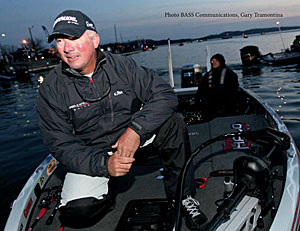
Thankfully, most lipless crankbait manufacturers offer a variety of sizes and colors. If you’re new to the body of water you’re fishing, do your research before you get there. Finding out what the bass eat on your body of water during this time of year will allow you to choose the color and size of your crankbait accordingly, and it will also mean you’ll be catching more fish.
Many newer lipless crankbait models also can wobble and flutter on the fall. Experimenting with a few different models is a good idea once you find the one that works best that day, as each model will have a different action. These little details can add up quickly and make your day on the water more productive.
Tharp’s Gear Selection
Tharp typically carries three different sizes of the Rapala Rippin’ Rap. Having these sizes in his boat allows him to fish in various depths effectively. His color selection varies from chrome and gold to crawfish colors depending on the fish's mood and what they’re feeding on.
Tharp uses a 7’4” Halo cranking rod when fishing a lipless crankbait. The length of that rod allows him to make long casts and is sensitive enough to detect strikes when fishing the lipless bait slowly. He usually throws Gamma 14-pound fluorocarbon line. He will go up to 20-pound test if he’s fishing very heavy cover, but he finds 14-pound test is an excellent place to start. Tharp spools his line on a 6:2.1 Shimano Core casting reel. He finds this gear ratio is a good starting point and is versatile enough for him to do a little bit of everything with lipless baits. If he knows he will burn one all day, he’ll opt for a reel with a faster gear ratio.
Final Thoughts
Hopefully, Tharp’s insight will remind you to dust off the lipless crankbait box at the end of winter. They’ve caught a ton of fish over the years and still catch a ton of fish today. Their unique wobbling action on the fall, loud rattles, and the flash they produce are often what it takes to wake fish up in these cold water conditions. Pick apart some drops near spawning areas with these lures, especially if they have cover on them, and you’ll probably end up catching some giant bass. It’s certainly worked for Tharp, and it’ll work for you too.
Republished with permission by



